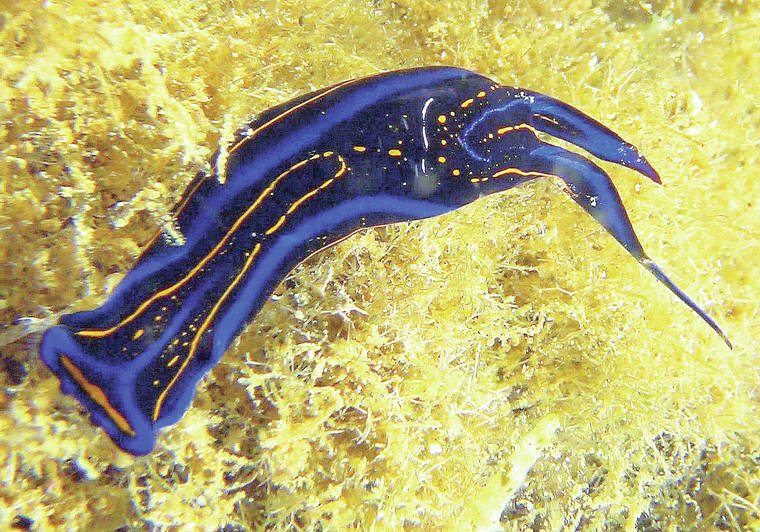This beautiful, one-inch-long sea creature is very common on Hawaiian coral reefs, but rarely ever seen. Hawaiian reefs are made from lava flows and filled with cracks and caves made when the hot lava cooled. Over time the corals grew on top of the lava reef, but below the corals the cracks and caves are just filled with sea creatures that rarely come out in the open.
This beautiful, one-inch-long sea creature is very common on Hawaiian coral reefs, but rarely ever seen. Hawaiian reefs are made from lava flows and filled with cracks and caves made when the hot lava cooled. Over time the corals grew on top of the lava reef, but below the corals the cracks and caves are just filled with sea creatures that rarely come out in the open.
I have been diving at ‘Anini Beach for 15 years and have never seen a blue swallowtail sea slug until two weeks ago. We are running our Coral Reef Kids Camp right now for 8 to 12 years olds, and we take them out snorkeling daily to visit with all the amazing marine life that lives in the shallow lagoon at ‘Anini. On one snorkel tour a young student spotted a dark-blue, very-tiny sea creature poking its head out of a small crack in the reef. When I came over to shoot a video of it I was amazed to see my very first blue swallowtail sea slug.
Over the past two weeks the students in the marine science camp have seen hundreds of these colorful little creatures, as they seem to all be coming up out of the reef to breed at the same time. This process often happens on or near a full moon, when a lot of secretive sea creatures come out into the open to spawn and produce offspring.
For the kids camp we had the state Department of Land and Natural Resources Division of Aquatic Resources come down to ‘Anini with several microscopes, and we collected some of the inch-long slugs and looked at their beautiful colors that you just can’t see when they are out on the reef.
These sea slugs have a tiny shell in their soft body, but they cannot fully retract into the shell. For protection, these very-primitive sea creatures have a wedge-shaped head that they use to bury under the sand, and when they are disturbed they emit a toxic yellow substance that keeps them from being eaten by fish.
We think the swallowtail slugs feed on small worms but we really do not know much about them because we can rarely ever find one. It was such a special treat for the students in the class to be able to see dozens of these secretive animals out on top of the reef because within a few days they will disappear again for another year.
Our Hawaiian coral reefs and lava caves are just filled with sea creatures that are rarely seen and poorly understood. It would be good to spend more time and money teaching children about sea creatures so they can grow up with a better understanding as to how the oceans are so important to the health and sustainability of the planet we live on.
•••
Terry Lilley, a marine biologist, lives in Hanalei. His websites include underwater-2web.com and www.gofundme.com/5urrm4zw.

Subscribe today for unlimited access.
Already a subscriber?
Login
Not ready to subscribe?
Register for limited access.
If you have a print subscription but require digital access,
activate your account.






Mahalo , Mr Lilley for your informative articles. I don’t see many comments but I’m sure others enjoy them as much as I.
Another good article on our sea life.
Very interesting. Having been to anni beach many times. Always found snorkeling very good. Really enjoy and look forward to ready about about the garden island ocean creatures. Sounds like a excellent program Mr. Lilley.